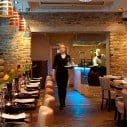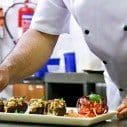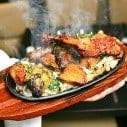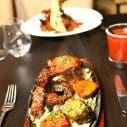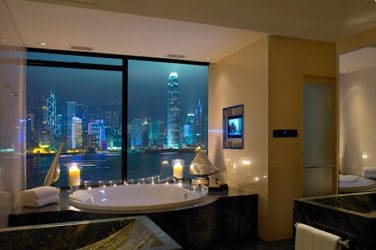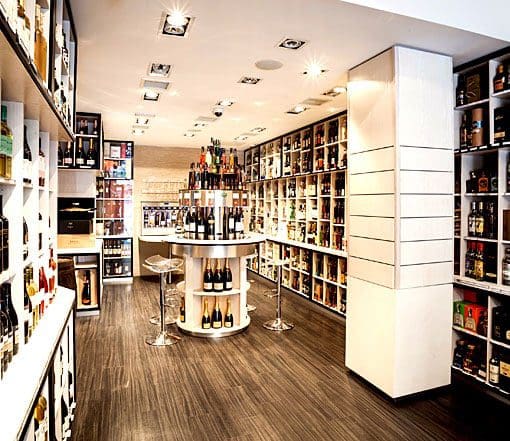‘Modern Indian Cuisine’ is a phrase wrought with gastro-complications, for while it proclaims a particular modernity, it in fact denotes a sort of fusion cuisine emblematic of the Noughties; a time when Britain’s classic curry-culture flirted with abstraction and haute-something-or-the-other.
With the conceptual authenticity and tradition of London street-food names such as Dishoom, or by contrast the Michelin stars of Gymkhana and Benares, reimagining our relationship with Indian subcontinent food, ‘Modern Indian Cuisine’ is left in a precarious position, where its attempts to make the Indian gastronomic experience relevant often find it stuck in a particular time and place that defy the current zeitgeist.
Salaam Namaste, a proud bastion of this very ‘Modern Indian Cuisine’, is gently placed on a Bloomsbury side street, around the corner from the UCL and Great Ormond Street Hospital. This is Richard Curtis’ London, and as decal-glass-fronted eatery is approached one can’t help imagine a young, bumbling Hugh Grant charm his way in to a lady’s heart as they ponder the experimentation afoot in the dishes in front of them. The restaurant is decidedly of the previous decade; cream leather banquets, purple-hued lighting and chilled beats set the tone for a venue stuck somewhere between a curry house and lounge bar. The waist-coated waiters and heavy laminate-leather bound menus impose a particular fine-dining formality that seems unbecoming of the dated and weathered decor. We are served swiftly with water, while we ponder the drinks menu. Salaam Namaste’s cocktail list is much as you’d expect; a few disco classics lengthened with some zesty-fruity house creations squarely aimed at those with sweeter palates. A balanced wine list and selection of curry-house lagers satiates those unmoved by the mixed drinks on offer.
Complimentary amuse-bouche of Dahi Puri are placed upon the table – a crunchy, puffy puri shell filled with a yoghurt and tamarind based filling. Their simplicity works wonders as a palate cleanser; a restrained use of spice creating just enough anticipation for my companion and I to stop small-talking and focus on the menu.
Spoilt for choice on starters, we allow the waiter to guide us towards a mixed grill and the Scallops ‘Three Ways’. Upon arrival, the minimalist presentation of both dishes is obscured by shredded ‘salad-stuff’ in the corner of the rectangular plates. Dry, cold and tasteless, it is the sort of ineffectual mass-garnish filler that detracts from the aesthetics of the very food it aims to accentuate. The mixed grill consists of a dry, overcooked and under-spiced lamb shank that deflects the best intentions of our cutlery to carve out morsels to eat. Alongside this comes a similarly overcooked spiced king prawn, and an indecipherable yellow kebab-thingy which is as tasty as it is mystifying. The scallops, though billed as being ‘Three Ways’ are in fact three scallops, cooked the same way, and placed each in small dishes of different sauces. The concept is novel, allowing an insight into the interplay between the idiosyncrasies of the scallop itself and the endless possibilities of dressing. But the three sauces on offer (mint-and-coriander, yellow ‘coconutty’ curry and tangy-tomato) bear a striking resemblance to descriptions of other dishes on the menu. My companion floats the idea that each scallop is merely dressed with a spoonful of recycled sauce, pre-batched for different, larger dishes. It’s by no means an unpleasant dish to eat, but I think he’s right. At this juncture it seems ‘Modern’ is a matter of expediency.
The arrival of the mains, however, brought with it a welcome disconnect from the downbeat starters. While the heavily shredded Crab Balchao may leave little room for the meat to speak for itself amongst the oil-heavy seasoning, the slow-cooked Lamb Shank ‘Kaliyan’ has those instant-hit, fall-of-the-bone morsels of tender meat, coated in a rich and aromatic pepper-forward sauce. A stunning contrast to this comes in the form of green banana and sweet mango curry. The tart, yellow coconut-milk sauce provides a smooth arena for the interplay between the contradictory profiles and textures of the two fruits. The green bananas are herbaceous and firm to the bite, and courageously tempered by the sharp tartness of the mango. Fragrant pilau rice and garlic naans are dutiful accompaniments to, and bridges between, these two standout main dishes.
The triumphant main courses gave way to admirable deserts. The sculpted, warm mound of Gajal Halwa, decorated by an elegant scoop of coconut ice cream, is sweet and savoury in equal measure; a textured mouth-feel that reveals tumeric and rose water flavours with each turn of the tongue. The Gulab Jaman, similarly poised to brave the idiosyncratic indulgence of authentic Indian confection, captures the spongy texture and syrupy sweetness that I remember so well from eating these traditional delights during a school holidays spent at my grandmothers house in (er…) East London.
Reeling from the richness of the third course, our minds turned to hot beverages. Having spied a lacklustre Nespresso-style machine behind the bar, we opted for Masala Chai over coffee. Though noble in effort, the particular blend of spices doesn’t quite cut the grade; too much cardamom and peppercorn, and not enough cinnamon or ginger make for an unpleasant experience upon the addition of milk, leaving my companion and I with a slightly metallic taste in the mouth as we make to leave. With the opening and closing of the door with diners and an industrious take-away driver, it is clear that Salaam Namaste is busy, and is doing well. Though with the balance of hits and misses one would expect from this genre of cuisine and level of venue, and the sorts of prices more in line with the restaurant’s location rather than the quality of food, it begs the question whether the general adequacy are the things really keeping it going; the restaurant is there, and ‘it’ll do’. The Salaam Namaste restaurant prides itself in being ‘vastly different from the norm’ (as their website dutifully informs me) but my companion and I can’t help but feel we’ve seen this – the lighting, the décor, the scatty bathrooms, that coffee machine and of course, the food – all before, somewhere out in the suburbs and for significantly less money.
words Rajan Virdee


